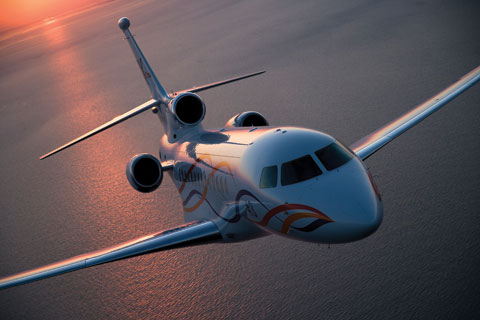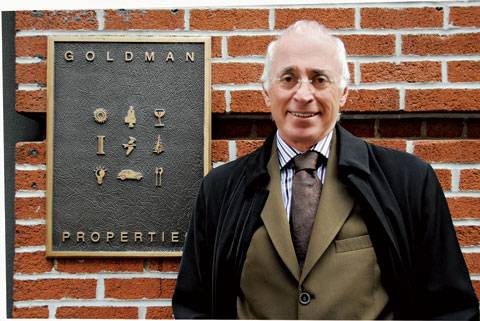A luxury aircraft combining the style and comfort of corporate travel with the technology and sleek design of a fly-by-wire fighter, Dassault Falcon’s new Falcon 7X is the ideal private jet for the 21st century.
By Benjamin Minkus
“The actual plane is designed and built in France, but the interiors are installed in Little Rock, Arkansas.”
The travel demands of an increasingly global business world may call for you to hop a plane from New York to Honolulu, Paris to Tokyo, or Miami to Buenos Aires, all on a minute’s notice. Thankfully, Dassault Falcon’s newest corporate aircraft, launched this year, can take you to these destinations faster, more efficiently, and with tremendous comfort.
With luxurious appointments meant to accommodate flights lasting upwards of 12 hours, the Falcon 7X provides modern corporations the ability to fly non-stop to Cloud Nine. And, with a unique design incorporating years of fighter-jet design, this $40.6 million global-range aircraft can get you there in no time. Provided, of course, you’re willing to wait six years to receive your order.
Based in France, Dassault Aviation has been involved in the industry for nearly a century. The company originally started before World War I in the manufacturing of airplane propellers. Following World War II, the company shifted its ambitious goals toward building fighter jets, and, by the 1960s, corporate jets.
“Dassault Falcon is the only aerospace company in the world that builds both fighter and corporate jets,” says Andrew Ponzoni, the public relations manager at South Hackensack, New Jersey-based Dassault Falcon, a subsidiary of Dassault Aviation. “We are also the only aerospace company still owned by its founding family.” What has resulted is a seamless melding of corporate luxury and advanced technology.
The design of the Falcon 7X eschews the dreadful, cramped amenities of commercial travel. With a stand-up height of six feet, two inches, a width of seven feet, eight inches, and eight feet of cabin length, the Falcon 7X comfortably holds up to eight passengers, in addition to three pilots and a flight attendant. With a low cabin altitude of 6,000 feet (standard planes are pressurized to a maximum altitude of roughly 8,000 feet), clients can deplane from the Falcon 7X feeling more rested.
The main cabin, masterfully appointed with fine English leather and lush carpeting, is designed to create three separate passenger seating areas, providing an intimate workspace and cherished privacy, which can be further accomplished thanks to the ability to close off the entire forward working area from the rest of the cabin.
“All of our interiors-the design and build-are by hand,” Ponzoni says. “The actual plane is designed and built in France, but the interiors are installed in Little Rock, Arkansas.”
Additionally, the Falcon 7X utilizes “quieting acoustics,” which practically eliminate the noise that typically accompanies air travel. “It is the quietest Falcon ever built-around 50 decibels-which is extremely quiet for a business trip,” Ponzoni says.
The added amenity of two opulently appointed lavs, one located in the forward section and the other in the aft, provides changing space. A spacious galley houses enough space to serve six-course meals, taking corporate travel to a whole new level. And, with 28 windows positioned around the cabin, natural light and gorgeous viewing angles are readily available.
Of course, Dassault Falcon takes pride in customizing each Falcon 7X to specific client needs. With designers in New Jersey and Paris, Dassault Falcon can customize the cabin, whether you are on a business trip to Moscow or on your way to your summer house in the Caribbean.
While luxury is certainly a top demand for world travel, so is punctuality. Dassault Falcon made this a priority. The groundbreaking wing design, which provides advanced aerodynamic efficiency, takes the Falcon 7X to higher cruising speeds and affords the luxury of nonstop travel of up to 5,700 miles, and a maximum cruising altitude of 51,000 feet.
Equipped with a trio of Pratt & Whitney Canada PW307A engines, Dassault Falcon’s signature three-engine design is yet another catalyst for the Falcon 7X’s unrivaled efficiency. Combined with a maximum operating speed of .90 Mach (and cruise speeds above .85 Mach) the Falcon 7X always gives businesses the most direct route to any destination.
Such tremendous speeds do nothing to diminish the Falcon 7X’s uniquely smooth ride. The intuitive accuracy of the cockpit’s “EASy” (Enhanced Avionics System) flight deck, a result of exhaustive research and input from aviation experts, is designed with a simple interface that brings convenience to the pilots’ fingertips and unsurpassed safety to the passengers. Rather than a standard yoke found on most aircraft, the Falcon 7X utilizes a sidestick, which looks much like a computer joystick.
The financial appeal of the design is not to be overlooked, either. Falcon 7X owners can save millions of dollars annually, thanks to low fuel consumption and maintenance, both uncommon among typical corporate aircraft.
“The Falcon 7X, compared to direct competition, burns 25-30% less fuel, even with a third engine,” Ponzoni says. “Our competition, with two engines, still can’t match that, thanks to the advanced design of the wing and the digital flight control system.”
The aggressive design means that excursions on the Falcon 7X are never “trimmed” (when minute adjustments are made to the nose and the left and right steering). The end result is a smoother ride and better fuel efficiency.
If all this seems too good to be true, it is-at least for now. Thanks to a plethora of orders following the initial launch announcement at the 2001 Paris Air Show, more than 170 Falcon 7X aircraft have been sent for delivery. Meanwhile, sales are so brisk that the next available delivery position is set for 2013.
Of course, in a global business world, time flies.





















